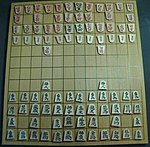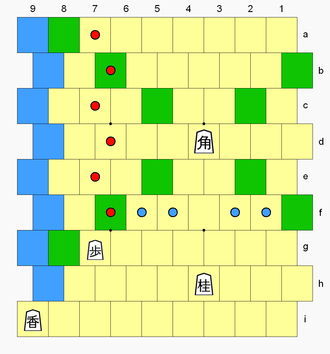Masonic shogi

Masonic shogi is a shogi variant invented by George R. Dekle Sr. in 1987.[1][2] The game is played on a modified shogi board whereby alternating ranks are indented to the right—resembling masonry brickwork. The moves of pieces are adapted to the new geometry; in other respects the game is the same as shogi.
Masonic shogi was included in World Game Review No. 10 edited by Michael Keller.[3]
Board characteristics
[edit]Indentation of alternating ranks results in cants (oblique files) approximately 30 degrees from the vertical and diagonals approximately 30 degrees from the horizontal, the same as hexagon-based chessboards when cell vertices face the players. (For example, rooks have six directions of movement. Masonic bishops, however, are limited to the four diagonal directions to the sides.)
Game rules
[edit]All normal shogi rules apply, including initial setup (see diagram), drops, promotion, and so on. The pieces, however, have specially defined moves.
Piece moves
[edit]The diagrams show how the unpromoted pieces move. As in shogi, a dragon king (promoted rook) moves as a rook or as a king. A dragon horse (promoted bishop) moves as a bishop or a king.
See also
[edit]- De Vasa's hexagonal chess
- Also by George Dekle:
- Masonic Chess
- Hexshogi – a variant with hexagonal cells
- Trishogi – a variant with triangular cells
- Space Shogi – a 3D variant
Notes
[edit]- ^ The Masonic rook has the same movement as the rook in Gliński's hexagonal chess (Pritchard 2007:260).
References
[edit]- ^ Pritchard (1994), p. 191
- ^ Pritchard (2007), p. 260
- ^ Keller, Michael, ed. (June 1991). "A Panorama of Chess Variants". World Game Review. No. 10. Michael Keller. ISSN 1041-0546.
Bibliography
- Pritchard, D. B. (1994). The Encyclopedia of Chess Variants. Games & Puzzles Publications. ISBN 0-9524142-0-1.
- Pritchard, D. B. (2007). Beasley, John (ed.). The Classified Encyclopedia of Chess Variants. John Beasley. ISBN 978-0-9555168-0-1.
Standard shōgi (9×9, drops) | ||
| Small variants |
|  |
| Standard-size variants |
| |
| Large variants |
| |
| Multiplayer variants |
| |
| 3D variants |
| |
| Miscellaneous variants |
| |
Text is available under the CC BY-SA 4.0 license; additional terms may apply.
Images, videos and audio are available under their respective licenses.


